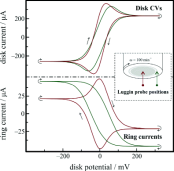
Electrical cross-talk in four-electrode experiments: A digital simulation approach to the example of rotating ring-disk electrodes
The paper authored by
S. Vesztergom,
N. Barankai,
N. Kovács,
M. Ujvári,
H. Siegenthaler, P. Broekmann and
G. G. Láng
is published in Journal of Solid State Electrochemistry (2016, vol. 20, pp. 3165–3177).
Abstract:
The subject of this paper is electrical cross-talk, an interference between the current/voltage characteristics of the two working electrodes in four-electrode (generator/collector) systems. Cross-talk arises in electrochemical cells of finite resistance due to the superposition of the electrical fields of the working electrodes, and often causes difficulties in the interpretation of measurement results. In this paper, we present an algorithm for modelling simple generation/collection experiments with a rotating ring-disk electrode (RRDE) immersed into a finite resistance solution of a redox couple. We show that based on the analysis of the Kirchhoff (Laplace) matrix of the simulation mesh, the effect of electrical cross-talk may be accounted for in such experiments. The intensity of cross-talk is found to be heavily influenced by the selection of the reference point for potential measurements; in practice, this is the position of the reference electrode or the tip of the Luggin probe. The devised model is validated by means of a simple and demonstrative experiment.
